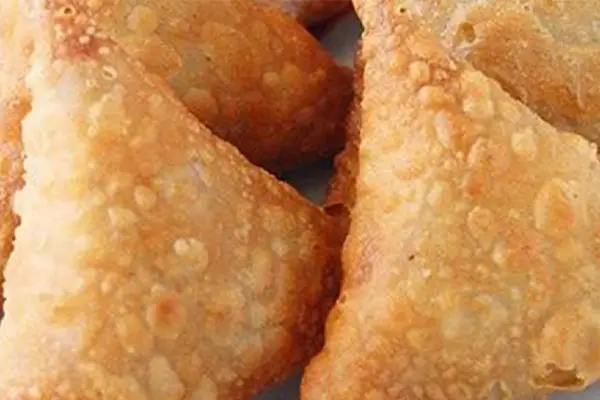Indian samosas are a popular snack and street food, cherished across India and beyond. These triangular-shaped pastries are typically filled with a spicy mixture of potatoes, peas, and sometimes meat, then deep-fried to golden perfection. Their crispy exterior and savory filling make them a beloved choice for a snack or appetizer, enjoyed with a variety of chutneys.
FAQs about Indian Samosas
- What are the typical fillings for Indian samosas?
- Indian samosas are traditionally filled with a spicy mix of mashed potatoes, peas, and spices. Non-vegetarian versions may include minced meat such as lamb, chicken, or beef.
- Are samosas served with any accompaniments?
- Yes, samosas are often served with mint chutney, tamarind chutney, or yogurt-based sauces for dipping.
- Can samosas be baked instead of fried?
- While deep-frying is traditional, samosas can also be baked for a healthier alternative. Baking offers a less oily finish but still provides a crisp texture.
- How are samosas made?
- Samosas are made by rolling out dough into circles, cutting them in half, and then forming each half into a cone shape. The filling is added to the cone, which is then sealed and deep-fried until golden.
- Are there any regional variations of samosas in India?
- Yes, samosas have various regional variations across India. Ingredients and shapes can vary; for example, in some places, samosas are filled with noodles or lentils.
- Can samosas be made vegan?
- Absolutely! By ensuring the dough is made without animal products and using vegetable fillings, samosas can easily be made vegan.
Conclusion
Indian samosas are a quintessential snack that embodies the rich culinary traditions of India. With their crispy exterior, savory filling, and the joy they bring when shared among friends and family, samosas continue to be a cherished treat in Indian cuisine and worldwide. Whether enjoyed at a street stall, a family gathering, or as part of a festive celebration, samosas are a testament to the enduring appeal of Indian flavors and culinary craftsmanship.

Indian Samosas
Description
Enjoy the crispy, flavorful Indian Samosas, perfect for a snack or a delicious starter for any meal! ????️✨
Ingredients
- ???? 2 cups all-purpose flour
???? 1/2 teaspoon salt
???? 4 tablespoons oil
???? Approx. 1/2 cup water (adjust as needed for dough)
Ingredients for the Filling: - ???? 2 large potatoes, boiled, peeled, and mashed
???? 1/2 cup peas (frozen or fresh)
???? 1 large onion, finely chopped
???? 2 teaspoons garam masala
????️ 1 teaspoon ground cumin
???? 1 teaspoon coriander powder
????️ 1/2 teaspoon red chili powder (adjust to taste)
???? Juice of 1 lemon
???? Salt to taste
???? Fresh cilantro, chopped
???? Oil for frying
Instructions
- Prepare the Dough: In a large mixing bowl, combine flour and salt. Add oil and rub into the flour with your fingers until the mixture resembles coarse breadcrumbs. Gradually add water and knead into a stiff dough. Cover and let it rest for at least 30 minutes.
- Prepare the Filling: In a pan, heat a little oil over medium heat. Add the onions and sauté until translucent. Add peas, mashed potatoes, garam masala, cumin, coriander, chili powder, and salt. Cook for 5-7 minutes. Turn off the heat and add lemon juice and cilantro. Mix well and let the filling cool.
- Assemble the Samosas: Divide the dough into equal portions. Roll each portion into a ball, then roll it out into a circle. Cut it in half. Take one half, form a cone shape, and seal the edge with a little water. Fill the cone with the potato mixture, then seal the open edges.
- Fry the Samosas: Heat oil in a deep frying pan over medium heat. Fry the samosas in batches until golden brown and crispy. Drain on paper towels.
- Serving: Serve hot with mint chutney or tamarind sauce for dipping.


